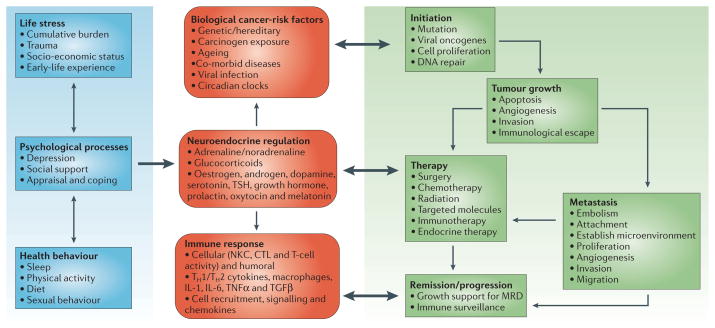Figure 2.
This integrated model illustrates how biobehavioral factors such as life stress, psychologic processes, and health behaviors (left panel) influence tumor-related processes (right panel) through neuroendocrine regulation of hormones including epinephrine (E), norepinephrine (NE), and glucocorticoids (center panel). Central control of peripheral endocrine function also allows social, environmental, and behavioral processes to interact with biologic risk factors such as genetic background, carcinogens, and viral infections to systemically modulate malignant potential (center panel). Direct pathways of influence include effects of catecholamines and glucocorticoids on tumor cell expression of genes controlling cell proliferation, invasion, angiogenesis, metastasis, and immune evasion (right panel). Furthermore, neuroendocrine dysregulation can influence the response to conventional therapies such as surgery, chemotherapy, and immunotherapy (right panel). In addition to explaining biobehavioral risk factors for cancer, this model suggests novel targets for pharmacologic or behavioral intervention. PRL, prolactin; OT, oxytocin; DA, dopamine; 5-HT, serotonin; TSH, thyroid-stimulating hormone; GH, growth hormone; NKCC, natural killer cell cytotoxicity; CTL, cytotoxic T-lymphocyte; TH1, T-helper lymphocyte type 1 cells; TH2, T-helper lymphocyte type 2 cells; Mf, macrophage; IL-1, interleukin-1; IL-6, interleukin-6, TNF-α, tumor necrosis factor-α; TGF-β, transforming growth factor-β). [Reprinted from Antoni MH, Lutgendorf SK, Cole SW, et al. The influence of bio-behavioural factors on tumour biology: pathways and mechanisms. Nature Reviews Cancer 6:240–248, 2006. Copyright, Antoni et al.]

